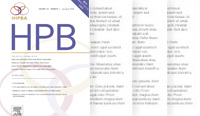International Hepato-Pancreato-Biliary Association
Laparoscopic distal pancreatectomy with possible splenectomy [case 14]
Post-op Debrief
Watch the following videos for the surgeons summaries of the case.
Key points from this case
When deciding whether to preserve the splenic vessels in a spleen preserving distal pancreatectomy, evaluate the anatomical relationship of the vessels at both the transection margin and the tail of the pancreas, and take care in any dissection at the splenic hilum. When performing a Warshaw technique, ensure there is adequate splenic perfusion from short gastric vessels.
The issues that the surgeons collectively identified preoperatively:
- Mobilization of cystic lesion in pancreas
- Dissection of splenic vessels
- Dissection of pancreatic neck
- Proximity of pancreatic tail to spleen
- Decision for splenic preservation
- Tumor proximity to left adrenal gland
- Pancreatic dissection margins
The issues were demonstrated in the intraoperative videos. So in summary, we were successful in performing a spleen preserving distal pancreatectomy laparoscopically in this patient. A few post-operative considerations to reflect upon is the fact that we did a vessel sacrificing procedure or Warshaw procedure. Due to the proximity of the lesion [off] to the splenic vein, I did not think that vessel preservation was appropriate and therefore, we divided the splenic artery and splenic vein proximally in the neck and distally in the splenic hilum and left the spleen on the short gastric vessels. We were able to preserve the gastroepiploic vessels as well as the short gastrics and we felt that splenic perfusion was adequate at the end.
In terms of other post-operative factors, the plane posterior to the pancreas was relatively well preserved and therefore we did not need to enter into Gerota’s fascia or resect the adrenal gland. The lesion itself though was quite adherent to the transverse mesocolon and therefore we did need to resect an avascular portion of transverse mesocolon. This created a mesenteric defect that needed to be closed at the end of the case to reduce the risk of internal hernia in the future.
Acknowledgements
Thank you to the HPB Surgeons who contribute their time and expertise. This content is made possible through educational grants from:

![]()
Views and opinions expressed in all videos and module content are those of the individual surgeon and solely intended for surgical education purposes. We do not endorse any product, treatment or therapy.
Corporate Partners
If you are interested in becoming a Corporate Partner of the IHBPA please contact industry@ihpba.org
Find out more






